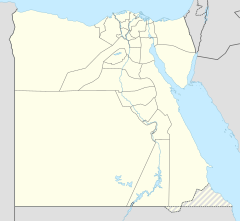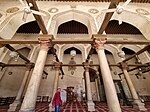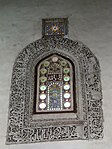Al-Salih Tala'i Mosque
| al-Salih Tala'i Mosque | ||
|---|---|---|
مسجد الصالح طلائع | ||
Year consecrated 1160 | | |
| Location | ||
| Location | Cairo, Egypt | |
| Geographic coordinates | 30°02′32″N 31°15′28″E / 30.04222°N 31.25778°E | |
| Architecture | ||
| Type | mosque | |
| Style | Fatimid | |
| Completed | 1160 | |
The Mosque of al-Salih Tala'i (
History

Construction and context
The mosque was commissioned by
The
Mamluk restoration
The mosque was restored in the
Modern era and present day
The mosque was heavily restored in the early 20th century from near-ruin by the Comité de Conservation des Monuments de l'Art Arabe, but much of the original building survives.[6] Today, the base of the mosque (along with the shops that once lined its exterior) is nearly two metres below the current street level, illustrating how much the street level has risen in the city since the 12th century.[7]
Architecture
Exterior and general layout
The mosque was constructed on a raised platform whose base, at street level, had built-in alcoves on three sides (all except the qibla side) designed to host shops which contributed to the revenue of the mosque.[7][1] It was thus the first "hanging" mosque in Cairo, which is to say a mosque where the prayer space is raised above street level.[1] The mosque has three entrances: a front entrance to the northwest and two lateral entrances on the sides. The front (northwestern) entrance is fronted by a portico with five arches, a feature which was unique in Cairo (at least before the much later Ottoman period) and might have been intended either as a royal viewing platform for processions through Bab Zuweila[6] or for some other ceremonial purpose if the head of Husayn had been buried here as intended.[1] The ceiling directly behind or inside the portico is original and is one of the only ceiling of its kind preserved from the Fatimid period.[5] As mentioned above, the wooden doors at the entrance of the mosque today are replicas of the originals, now in the Museum of Islamic Art. Originally, a minaret also rose above the entrance of the mosque, but was destroyed in the 1303 earthquake. A later minaret added during the Ottoman period was eventually removed during the 20th-century restoration.[1][6] The visible stairwell that still leads to the roof today probably marks its former location.[citation needed]
The exterior walls are decorated with keel arch-shaped recesses that appear besides the portico and along the sides of the mosque, providing some visual unity with the keel arches of the front portico.[6] These blind arches once had windows set within them, but these have been walled up.[5] Other decorations on the walls include carved moldings and several horizontal bands containing Kufic Arabic inscriptions, including one that ran along the very top of the façade but has largely disappeared today. Fragments of stucco-carved crenellations that once ran along the top of the walls can be seen on the northeast side. At both ends of the northwest wall are chamfered corners with muqarnas, a feature that had previously been used at the al-Aqmar Mosque (late 11th century).[5]
-
Exterior of the mosque, seen from the west, with the entrance portico on the left. One of the mosque's chamfered corners is visible in the middle.
-
Northeastern wall and entrance of the mosque. Fragments of original crenellations are visible at the top.
-
Exterior of the mosque, with the former shop alcoves visible along the base (now half-buried and below street level)
-
One of the wooden mashrabiyya screens added to the front portico of the mosque during the Mamluk restoration (early 14th century)
Interior
The mosque's interior features a courtyard surrounded by an arcade of keel-shaped arches, with the qibla side (south-east side) extending deeper to form a prayer hall three rows deep.
-
Interior of the mosque (looking towards the qibla)
-
The prayer hall, with calligraphic stucco outlines around the arches and carved wooden tie-beams from the Fatimid era
-
TheMamlukera and is one of the oldest in Cairo.
-
Detail of the Mamluk minbar (dated to 1299–1300)
-
An stucco-carved window grille inside the mosque
-
An original stucco-carved window from the mosque, of the Fatimid period, now on display at the Museum of Islamic Art
See also
References
- ^ a b c d e f g h i j k Williams, Caroline (2018). Islamic Monuments in Cairo: The Practical Guide (7th ed.). Cairo: The American University in Cairo Press. pp. 124–126.
- ^ Raymond, André (1993). Le Caire (in French). Fayard. p. 79.
- ^ a b c O'Kane, Bernard (with contributions by Mohamed Abbas and Iman R. Abdulfattah). 2012. The Illustrated Guide to the Museum of Islamic Art in Cairo. Cairo, New York: The American University in Cairo Press, p. 80.
- ^ Raymond, André (1993). Le Caire (in French). Fayard. p. 65.
- ^ ISBN 9789004096264.
- ^ ISBN 9789774167324.
- ^ a b Raymond, André. 1993. Le Caire. Fayard, p. 65.
External links
- Creswell's photo of the mosque's entrance and minaret (prior to the mosque's 20th century restoration), V&A collection













